小学二年级英语语法总结
小学二年级英语语法知识点
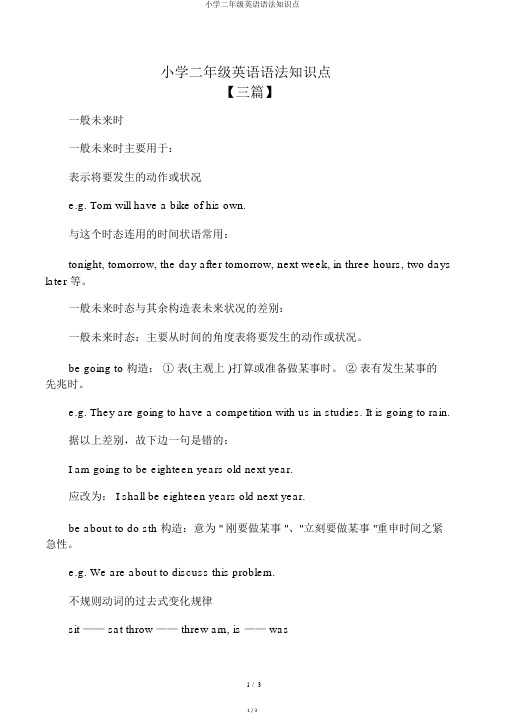
小学二年级英语语法知识点【三篇】一般未来时一般未来时主要用于:表示将要发生的动作或状况e.g. Tom will have a bike of his own.与这个时态连用的时间状语常用:tonight, tomorrow, the day after tomorrow, next week, in three hours, two days later 等。
一般未来时态与其余构造表未来状况的差别:一般未来时态:主要从时间的角度表将要发生的动作或状况。
be going to 构造:①表(主观上 )打算或准备做某事时。
②表有发生某事的先兆时。
e.g. They are going to have a competition with us in studies. It is going to rain.据以上差别,故下边一句是错的:I am going to be eighteen years old next year.应改为: I shall be eighteen years old next year.be about to do sth 构造:意为 " 刚要做某事 "、"立刻要做某事 "重申时间之紧急性。
e.g. We are about to discuss this problem.不规则动词的过去式变化规律sit —— sat throw —— threw am, is —— wasdrink —— drank draw —— drew are —— weresing —— sang fly ——flew do —— didbegin —— began grow —— grew have, has—— had swim —— swam put —— put may —— mightgive —— gave cut —— cut can —— couldring —— rang let —— let shall ——shouldrun —— ran read —— read will —— wouldride —— rode catch —— caught go —— wentwrite —— wrote teach —— taught eat —— ate drive—— drove think —— thought hear —— heardkeep —— kept buy —— bought see —— sawsleep —— slept fight —— fought find —— foundsweep —— swept hold —— held wear ——wore feel —— felt tell —— told meet —— metcome —— came get —— got mean —— meantbecome —— became make—— made speak—— spoke take —— took say —— said1)is, am-was are-were2)begin-began ring-rang drink-drank swim-swam give-gave sing-sang sit-sat run-ran have-had make-made come-came eat-ate3)write-wrote ride-rode speak-spoke drive-drove stand-stood tell-told win-won get-got take-took4)sleep-slept sweep-swept feel-felt keep-keptspell-spelt spend-spent bend-bentmeet-met go-went5)know-knew fly-flew blow-blew grow-grewthrow-threw draw-drew (glow-glowed)6)teach-taught catch-caught buy-boughtfight-fought think-thought7)find-found hear-heard say-said lie-lay see-saw learn-learnt mean-meant8)put-put read-read cut-cut let-let规则动词的过去式词尾读音a.在浊辅音和元音后读 [d] ,如 lived, watered, listened, played。
二年级英语的语法知识点归纳
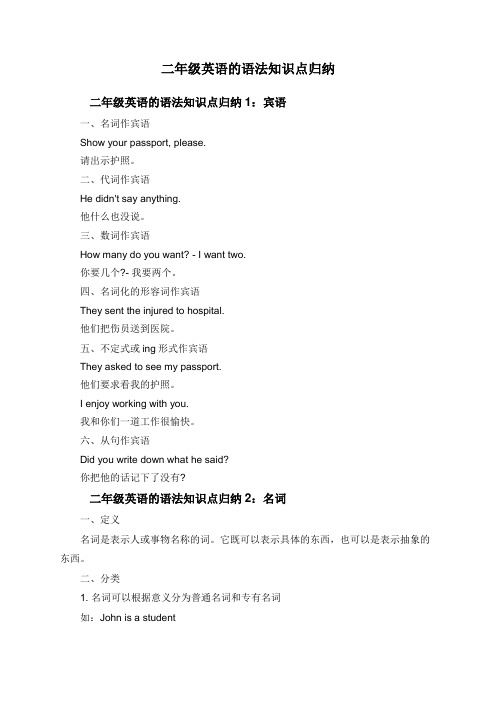
二年级英语的语法知识点归纳二年级英语的语法知识点归纳1:宾语一、名词作宾语Show your passport, please.请出示护照。
二、代词作宾语He didn't say anything.他什么也没说。
三、数词作宾语How many do you want? - I want two.你要几个?- 我要两个。
四、名词化的形容词作宾语They sent the injured to hospital.他们把伤员送到医院。
五、不定式或ing形式作宾语They asked to see my passport.他们要求看我的护照。
I enjoy working with you.我和你们一道工作很愉快。
六、从句作宾语Did you write down what he said?你把他的话记下了没有?二年级英语的语法知识点归纳2:名词一、定义名词是表示人或事物名称的词。
它既可以表示具体的东西,也可以是表示抽象的东西。
二、分类1. 名词可以根据意义分为普通名词和专有名词如:John is a studentstudent是普通名词,John是专有名词普通名词前可以用不定冠词a/an, 定冠词the 或不加冠词,专有名词前一般不加冠词,专有名词的首字母要大写。
2. 普通名词又可以分为个体名词、集体名词、物质名词和抽象名词,其中个体名词与集体名词是可数名词,物质名词和抽象名称是不可数名词。
3. 专有名词专有名词是表示人名、地名、团体、机构、组织等的专有名词,多为独一无二的事物。
三、名词的数1、名词分为可数名词和不可数名词。
可数名词——可以数的名词不可数名词——数不清(没有复数)Drink?milk tea water orange juice coke coffee porridgeFood?rice bread meat fish fruit cake dumplings2、可数名词与不定冠词a(an)连用有数数形式,不可数名词不能与不定冠词a(an)连用,没有复数形式many+可数名词复数much/a little+不可数名词some, any , a lot of (lots of) 两者都可以修饰。
上海小学二年级英语语法归纳总结
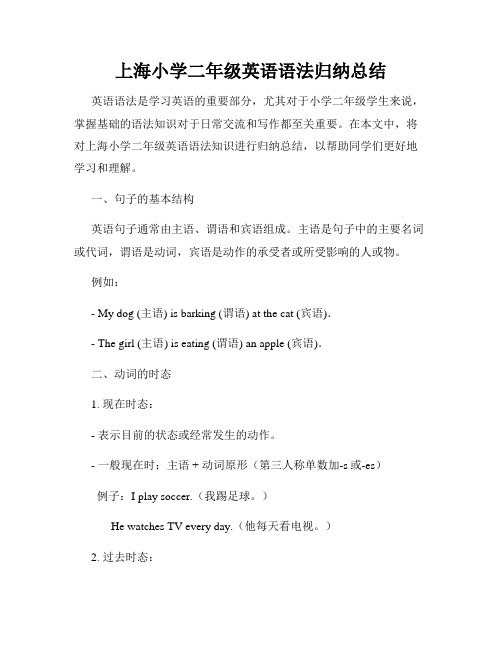
上海小学二年级英语语法归纳总结英语语法是学习英语的重要部分,尤其对于小学二年级学生来说,掌握基础的语法知识对于日常交流和写作都至关重要。
在本文中,将对上海小学二年级英语语法知识进行归纳总结,以帮助同学们更好地学习和理解。
一、句子的基本结构英语句子通常由主语、谓语和宾语组成。
主语是句子中的主要名词或代词,谓语是动词,宾语是动作的承受者或所受影响的人或物。
例如:- My dog (主语) is barking (谓语) at the cat (宾语).- The girl (主语) is eating (谓语) an apple (宾语).二、动词的时态1. 现在时态:- 表示目前的状态或经常发生的动作。
- 一般现在时:主语 + 动词原形(第三人称单数加-s或-es)例子:I play soccer.(我踢足球。
)He watches TV every day.(他每天看电视。
)2. 过去时态:- 表示过去发生的动作或状态。
- 一般过去时:主语 + 动词过去式例子:I played soccer yesterday.(我昨天踢足球了。
)She watched a movie last night.(她昨晚看了一部电影。
)3. 将来时态:- 表示将来要发生的动作或情况。
- 一般将来时:主语 + will + 动词原形例子:I will go to the park tomorrow.(我明天要去公园。
)They will have a party next week.(他们下周要开派对。
)三、名词名词是指人、物、地点或概念。
在句子中一般作为主语、宾语或补语。
1. 可数名词:- 单数形式:一个 + 名词单数形式- 复数形式:两个(几个)+ 名词复数形式例子:There is a cat.(这里有一只猫。
)There are two cats.(这里有两只猫。
)2. 不可数名词:- 通常表示无法具体计数的名词。
小学生二年级英语语法总结
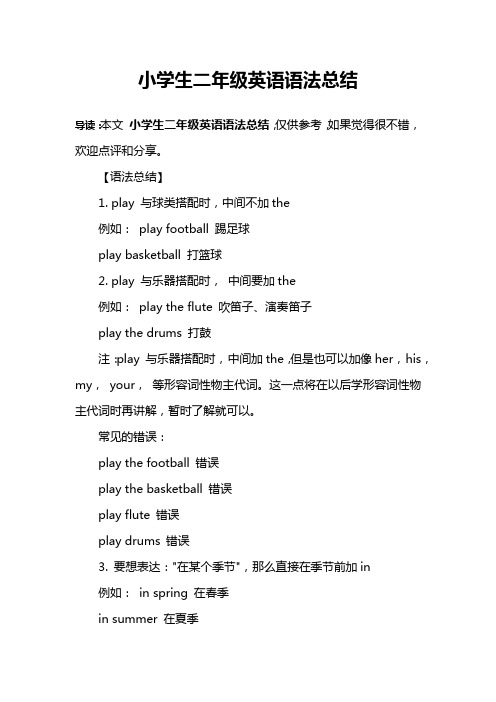
小学生二年级英语语法总结导读:本文小学生二年级英语语法总结,仅供参考,如果觉得很不错,欢迎点评和分享。
【语法总结】1. play 与球类搭配时,中间不加the例如:play football 踢足球play basketball 打篮球2. play 与乐器搭配时,中间要加the例如:play the flute 吹笛子、演奏笛子play the drums 打鼓注:play 与乐器搭配时,中间加the,但是也可以加像her,his,my,your,等形容词性物主代词。
这一点将在以后学形容词性物主代词时再讲解,暂时了解就可以。
常见的错误:play the football 错误play the basketball 错误play flute 错误play drums 错误3. 要想表达:"在某个季节",那么直接在季节前加in例如:in spring 在春季in summer 在夏季in autumn 在秋季in winter 在冬季常见的错误:in the summer (错误)at winter (错误)at the spring (错误)on autumn (错误)4. 要想表达:"在早、中、晚",那么用in the 再加上早中晚例如:in the morning 在早晨、在上午in the afternoon 在中午、在下午in the evening 在晚上常见的错误:in morning (错误)at afternoon (错误)in evening (错误)注:night 特殊,要用at例如:at night 在晚上5. 在几点钟前面要用at,无论是整点、半点、还是几点几分,都在时间前直接加at。
例如:at five o'clock 在五点at half past eleven 在十一点半at twelve ten 在十二点十分常见的错误:at the five o'clock 错误in half past ten 错误on the ten o'clock 错误 6. 在城市、国家等大地点前面直接加in,并且城市、国家的首字母需要大写。
二年级英语语法的知识点归纳

二年级英语语法的知识点归纳一、名词名词是指人、事、物、地方等,如:cat、dog、book、pen等。
在英语中,名词有单数和复数之分。
如果名词是单数,一般在后面加 -s 变成复数,例如:pen(单数)变成 pens(复数)。
二、动词动词是指表示行为、状态或经验等的词语,如:sing、dance、run、play等。
在英语中,动词有现在式、过去式和将来式。
例如:play(现在式)变成 played (过去式),play(现在式)变成 will play(将来式)。
三、形容词形容词是用来修饰名词、代词或其他形容词的词语,如:happy、sad、big、small等。
在英语中,形容词有原级、比较级和最高级。
例如:big(原级)变成bigger(比较级),biggest(最高级)。
四、副词副词是用来修饰动词、形容词、副词或句子的词语,如:quickly、slowly、often、never等。
在英语中,副词也有原级、比较级和最高级。
例如:quickly(原级)变成 more quickly(比较级),most quickly(最高级)。
五、代词代词是用来代替名词或其他代词的词语,如:she、he、it、they等。
在英语中,代词有主格、宾格和所有格之分。
例如:I(主格)变成 me(宾格),my(所有格)。
六、介词介词是用来表示名词或代词与其他词之间的关系的词语,如:in、on、at、to 等。
在英语中,介词常常搭配一些固定的短语,例如:in front of、on top of、at the bottom of等。
七、连词连词是用来连接句子或词语的词语,如:and、or、but、because等。
在英语中,连词分为并列连词和从属连词。
例如:I like apples and oranges(并列连词),I will go to bed because I am tired(从属连词)。
八、冠词冠词是用来限定名词的词语,分为定冠词和不定冠词。
小学二年级英语语法汇总

小学二年级英语语法汇总如下:一、基本时态与动词形式1.一般现在时:o使用be动词(am/is/are)描述当前状态或习惯性动作。
o肯定和否定句结构:I am (not) a student. They are (not) playing.o一般疑问句结构及其回答:Are you a student? Yes, I am. / No, I'm not.1.动词的-ing形式:o表示正在进行的动作。
o构成方式:大多数动词加-ing(如walk-walking),以e结尾的动词去e加-ing (如come-coming),以一个元音和一个辅音结尾的重读闭音节动词,双写末尾辅音字母再加-ing(如run-running)。
o句子结构:be + verb-ing(如I am playing football.)。
二、句子结构1.陈述句(声明句):用于陈述事实或表达观点。
o肯定句:I like apples.o否定句:I don't like apples.1.疑问句:用于提出问题。
o一般疑问句:Are you happy?o特殊疑问句(如使用what, where, how等疑问词):What is your name?1.there be句型:用于描述某处存在某物。
o肯定句:There is a book on the table.o否定句:There isn't a book on the table.o疑问句:Is there a book on the table?三、名词与代词1.名词复数规则:o一般情况下,直接加-s(如book-books)。
o以s, x, sh, ch结尾的名词,加-es(如bus-buses)。
o以“辅音字母+y”结尾的名词,变y为i,再加-es(如family-families)。
o以“f或fe”结尾的名词,变f或fe为v,再加-es(如knife-knives)。
小学二年级英语语法总结

小学二年级英语语法总结一、主谓一致主谓一致是指主语和谓语在人称和数上要保持一致。
具体规则如下:1.如果主语是第三人称单数,谓语动词要加-s或-es。
–例如:He plays basketball every day.2.如果主语是第一人称或第二人称,谓语动词不加-s或-es。
–例如:I like ice cream.3.如果主语是复数形式,谓语动词不加-s或-es。
–例如:They go to the park every weekend.二、名词名词是表示人、事物、地方或抽象概念的词语。
在英语语法中,名词有以下几个基本特点:1.名词有单数和复数形式。
–单数形式一般是加-s,如book -> books。
–有些名词复数形式需要变换词尾,如man -> men,child -> children。
2.名词可以用来表示所有关系,有两种形式。
–加’s表示所有关系,如boy’s book。
–加of表示所有关系,如the book of the boy。
3.名词可以用来表示数量或限定范围。
–例如:a book, many books。
三、代词代词是用来代替名词的词语。
在英语语法中,代词有以下几个基本特点:1.主格代词用于代替主语。
–例如:I, you, he, she, it, we, they。
2.宾格代词用于代替动词的宾语。
–例如:me, you, him, her, it, us, them。
3.所有格代词用于表示所有关系。
–例如:mine, yours, his, hers, its, ours, theirs。
4.反身代词用于表示主语和动词的宾语是同一个人或物。
–例如:myself, yourself, himself, herself, itself, ourselves, yourselves, themselves。
四、动词动词是表示动作或状态的词语。
在英语语法中,动词有以下几个基本特点:1.动词有时态和语态的变化。
英语小学生二年级语法的汇总

英语小学生二年级语法的汇总小学生英语语法的重点【现在进行时】1.现在进行时表示现在正在进行或发生的动作,也可表示当前一段时间内的活动或现阶段正在进行的动作。
2.现在进行时的肯定句基本结构为be动词ing。
3.现在进行时的否定句在be后加not。
4.现在进行时的一般疑问句把be动词调到句首。
5.现在进行时的非凡疑问的基本结构为:疑问词不达意 be 主语动词ing但疑问词当主语时其结构为:疑问词不达意 be 动词ing动词加ing的变化规则1.一般情况下,直接加ing,如:cook-cooking2.以不发音的e结尾,去e加ing,如:make-making,taste-tasting3.假如末尾是一个元音字母和一个辅音字母,双写末尾的辅音字母,再加ing,如:run-running, stop-stopping 英语语法知识点【一般过去时态】(a) be 动词的过去式:I/He/she/it was(not). You/we/they were.一般疑问句was, were 放在句首。
(b) 动词过去式:肯定句: I watched cartoons.She visited the zoo.一般疑问句: Did you read book last night Yes, I did. No, I didnt.Did she clean the desk just now Yes, she did. No, she didnt.否定句: They didnt go the the part yesterday.He didnt make model ships last week.(3)动词过去式的变化:规则动词的变化:Most verbs +ed eg. planted,watered,climbed。
Verbs ending in e +d eg liked。
Verbs ending in a consonant +y --y +ied eg : study-studiedShort verbs ending in a vowel + a consonant eg: stop --stopped不规则动词的变化:is/am-was,are-were,do-did,have/has-had,make-made,fly-flew/u:/eat-ate,take-took,run-ran,sing-sang,drink-drank 等等英语二年级的语法【一般现在时】通常用 usually, often, every day, sometimes。
英语二年级知识点总结
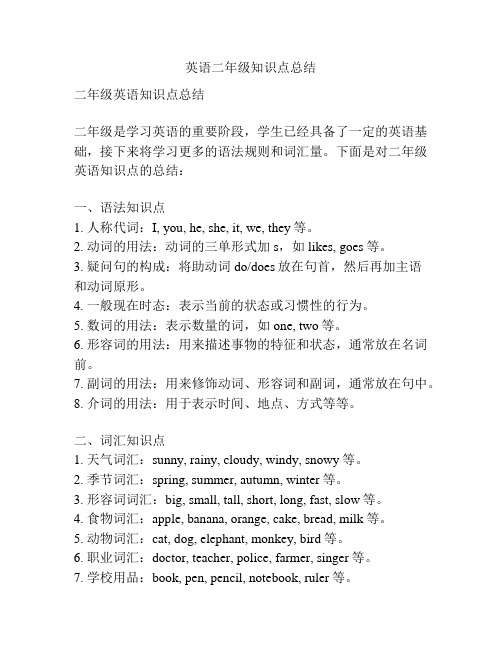
英语二年级知识点总结二年级英语知识点总结二年级是学习英语的重要阶段,学生已经具备了一定的英语基础,接下来将学习更多的语法规则和词汇量。
下面是对二年级英语知识点的总结:一、语法知识点1. 人称代词:I, you, he, she, it, we, they等。
2. 动词的用法:动词的三单形式加s,如likes, goes等。
3. 疑问句的构成:将助动词do/does放在句首,然后再加主语和动词原形。
4. 一般现在时态:表示当前的状态或习惯性的行为。
5. 数词的用法:表示数量的词,如one, two等。
6. 形容词的用法:用来描述事物的特征和状态,通常放在名词前。
7. 副词的用法:用来修饰动词、形容词和副词,通常放在句中。
8. 介词的用法:用于表示时间、地点、方式等等。
二、词汇知识点1. 天气词汇:sunny, rainy, cloudy, windy, snowy等。
2. 季节词汇:spring, summer, autumn, winter等。
3. 形容词词汇:big, small, tall, short, long, fast, slow等。
4. 食物词汇:apple, banana, orange, cake, bread, milk等。
5. 动物词汇:cat, dog, elephant, monkey, bird等。
6. 职业词汇:doctor, teacher, police, farmer, singer等。
7. 学校用品:book, pen, pencil, notebook, ruler等。
三、日常用语1. 问候语:Hello, Hi, Good morning, Good afternoon, Good evening等。
2. 再见:Goodbye, Bye, See you, Take care等。
3. 感谢:Thank you, Thanks。
4. 道歉:Sorry, Excuse me。
二年级有关英语语法知识点总结
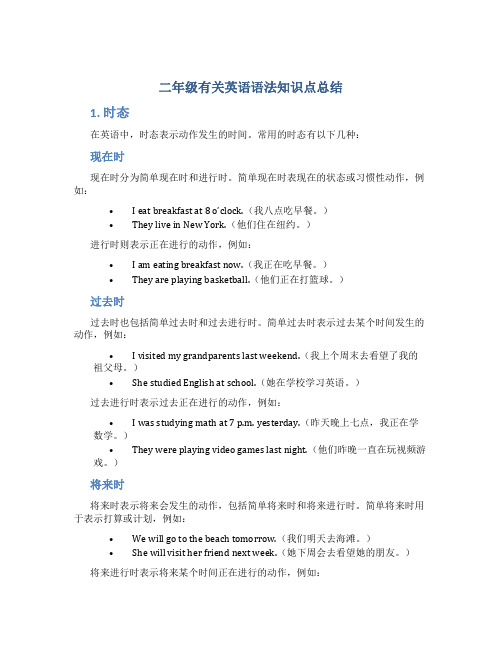
二年级有关英语语法知识点总结1. 时态在英语中,时态表示动作发生的时间。
常用的时态有以下几种:现在时现在时分为简单现在时和进行时。
简单现在时表现在的状态或习惯性动作,例如:•I eat breakfast at 8 o’clock.(我八点吃早餐。
)•They live in New York.(他们住在纽约。
)进行时则表示正在进行的动作,例如:•I am eating breakfast now.(我正在吃早餐。
)•They are playing basketball.(他们正在打篮球。
)过去时过去时也包括简单过去时和过去进行时。
简单过去时表示过去某个时间发生的动作,例如:•I visited my grandparents last weekend.(我上个周末去看望了我的祖父母。
)•She studied English at school.(她在学校学习英语。
)过去进行时表示过去正在进行的动作,例如:•I was studying math at 7 p.m. yesterday.(昨天晚上七点,我正在学数学。
)•They were playing video games last night.(他们昨晚一直在玩视频游戏。
)将来时将来时表示将来会发生的动作,包括简单将来时和将来进行时。
简单将来时用于表示打算或计划,例如:•We will go to the beach tomorrow.(我们明天去海滩。
)•She will visit her friend next week.(她下周会去看望她的朋友。
)将来进行时表示将来某个时间正在进行的动作,例如:•I will be studying from 9 a.m. to 12 p.m. tomorrow.(我明天9点到12点会在学习。
)•They will be hiking in the mountains this weekend.(他们这个周末会去登山。
二年级英语的语法知识点归纳

二年级英语的语法知识点归纳二年级英语的语法知识点归纳1:宾语一、名词作宾语Show your passport, please.请出示护照。
二、代词作宾语He didn't say anything.他什么也没说。
三、数词作宾语How many do you want? - I want two. 你要几个?- 我要两个。
四、名词化的形容词作宾语They sent the injured to hospital. 他们把伤员送到医院。
五、不定式或ing形式作宾语They asked to see my passport.他们要求看我的护照。
I enjoy working with you.我和你们一道工作很愉快。
六、从句作宾语Did you write down what he said? 你把他的话记下了没有?二年级英语的语法知识点归纳2:名词一、定义名词是表示人或事物名称的词。
它既可以表示具体的东西,也可以是表示抽象的东西。
二、分类1. 名词可以根据意义分为普通名词和专有名词如:John is a studentstudent是普通名词,John是专有名词普通名词前可以用不定冠词a/an, 定冠词the 或不加冠词,专有名词前一般不加冠词,专有名词的首字母要大写。
2. 普通名词又可以分为个体名词、集体名词、物质名词和抽象名词,其中个体名词与集体名词是可数名词,物质名词和抽象名称是不可数名词。
3. 专有名词专有名词是表示人名、地名、团体、机构、组织等的专有名词,多为独一无二的事物。
三、名词的数1、名词分为可数名词和不可数名词。
可数名词——可以数的名词不可数名词——数不清(没有复数)Drink?milk tea water orange juice coke coffee porridgeFood?rice bread meat fish fruit cake dumplings2、可数名词与不定冠词a(an)连用有数数形式,不可数名词不能与不定冠词a(an)连用,没有复数形式many+可数名词复数much/a little+不可数名词some, any , a lot of (lots of) 两者都可以修饰。
二年级英语语法的知识点

一、动词的时态1.现在时态现在时态表示现在正在进行的动作或者客观事实。
常见的现在时态动词有is/am/are。
例如:I am a student.(我是学生。
)2.过去时态过去时态表示过去发生的动作或状态。
常见的过去时态动词有was/were。
例如:He was a teacher last year.(他去年是一名老师。
)3.将来时态将来时态表示将来要发生的动作。
常见的将来时态动词有will/shall。
例如:I will go to the park tomorrow.(我明天去公园。
)二、名词的单复数1.单数名词单数名词表示一个人、动物、物体或者概念。
一般情况下,单数名词前不加任何限定词。
例如:a cat(一只猫)2.复数名词复数名词表示多个人、动物、物体或者概念。
一般情况下,复数名词在词尾加-s或-es。
例如:two cats(两只猫)三、代词代词用来替代名词,可以简化语句结构。
常见的代词有人称代词、物主代词和指示代词。
1.人称代词人称代词用于表示说话人、被说话人和被谈论的人。
常见的人称代词有I、you、he/she/it等。
例如:I am a student.(我是学生。
)2.物主代词物主代词用来表示所有权。
常见的物主代词有my、your、his/her/its等。
例如:This is my book.(这是我的书。
)3.指示代词指示代词用来指示一些人或物。
常见的指示代词有this、that、these、those等。
例如:This is a pen.(这是一支笔。
)四、形容词形容词用来描述名词的性质或特征。
形容词一般放在名词前面。
常见的形容词有big、small、happy等。
例如:He has a big house.(他有一幢大房子。
)五、副词副词用来修饰动词、形容词或其他副词。
副词通常放在动词或形容词的后面。
常见的副词有quickly、slowly、happily等。
例如:She runs quickly.(她跑得快。
给小学二年级整理的英语语法知识点【三篇】
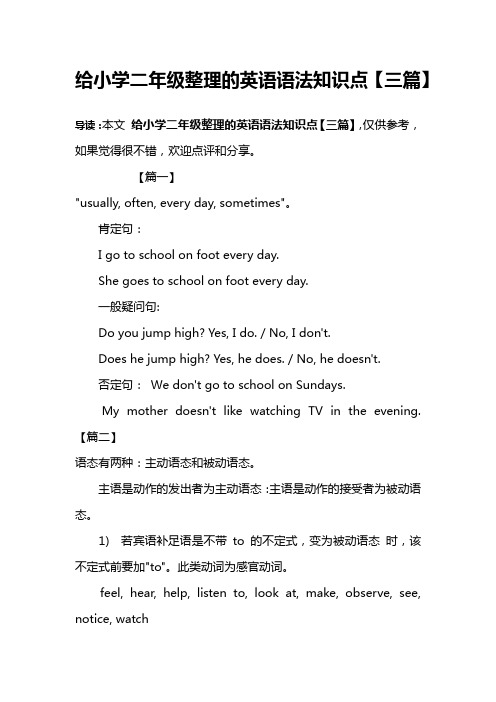
给小学二年级整理的英语语法知识点【三篇】导读:本文给小学二年级整理的英语语法知识点【三篇】,仅供参考,如果觉得很不错,欢迎点评和分享。
【篇一】"usually, often, every day, sometimes"。
肯定句:I go to school on foot every day.She goes to school on foot every day.一般疑问句:Do you jump high? Yes, I do. / No, I don't.Does he jump high? Yes, he does. / No, he doesn't.否定句:We don't go to school on Sundays.My mother doesn't like watching TV in the evening. 【篇二】语态有两种:主动语态和被动语态。
主语是动作的发出者为主动语态:主语是动作的接受者为被动语态。
1) 若宾语补足语是不带to 的不定式,变为被动语态时,该不定式前要加"to"。
此类动词为感官动词。
feel, hear, help, listen to, look at, make, observe, see, notice, watchThe teacher made me go out of the classroom。
--> I was made to go out of the classroom (by the teacher)。
We saw him play football on the playground。
--> He was seen to play football on the playground。
2) 情态动词+ be +过去分词,构成被动语态。
Coal can be used to produce electricity for agriculture and industry。
二年级英语语法的知识点
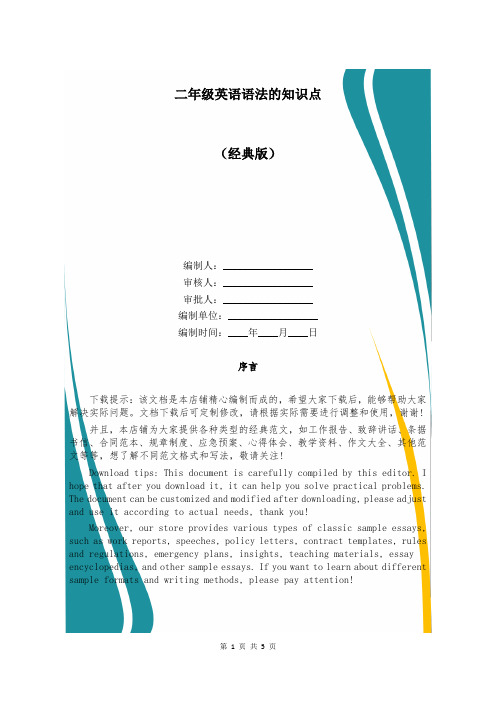
二年级英语语法的知识点(经典版)编制人:__________________审核人:__________________审批人:__________________编制单位:__________________编制时间:____年____月____日序言下载提示:该文档是本店铺精心编制而成的,希望大家下载后,能够帮助大家解决实际问题。
文档下载后可定制修改,请根据实际需要进行调整和使用,谢谢!并且,本店铺为大家提供各种类型的经典范文,如工作报告、致辞讲话、条据书信、合同范本、规章制度、应急预案、心得体会、教学资料、作文大全、其他范文等等,想了解不同范文格式和写法,敬请关注!Download tips: This document is carefully compiled by this editor. I hope that after you download it, it can help you solve practical problems. The document can be customized and modified after downloading, please adjust and use it according to actual needs, thank you!Moreover, our store provides various types of classic sample essays, such as work reports, speeches, policy letters, contract templates, rules and regulations, emergency plans, insights, teaching materials, essay encyclopedias, and other sample essays. If you want to learn about different sample formats and writing methods, please pay attention!二年级英语语法的知识点二年级英语语法的知识点大全正确的语法可以简化信息,简单的一句话就能传达很多信息,甚至包含多重意思,就像双关语一样。
二年级英语的语法知识点归纳
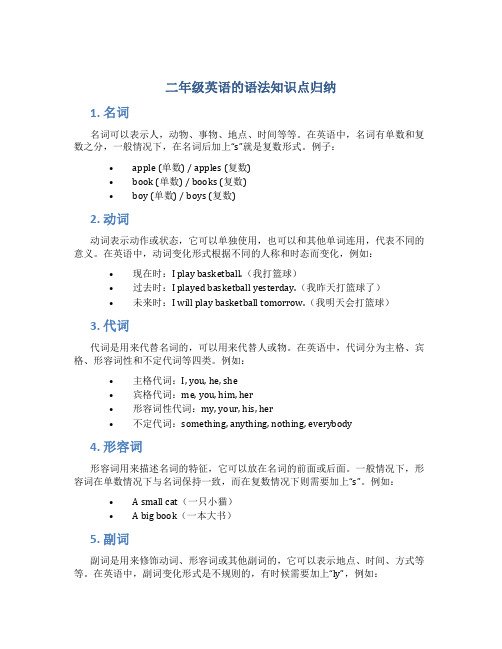
二年级英语的语法知识点归纳1. 名词名词可以表示人,动物、事物、地点、时间等等。
在英语中,名词有单数和复数之分,一般情况下,在名词后加上“s”就是复数形式。
例子:•apple (单数) / apples (复数)•book (单数) / books (复数)•boy (单数) / boys (复数)2. 动词动词表示动作或状态,它可以单独使用,也可以和其他单词连用,代表不同的意义。
在英语中,动词变化形式根据不同的人称和时态而变化,例如:•现在时:I play basketball.(我打篮球)•过去时:I played basketball yesterday.(我昨天打篮球了)•未来时:I will play basketball tomorrow.(我明天会打篮球)3. 代词代词是用来代替名词的,可以用来代替人或物。
在英语中,代词分为主格、宾格、形容词性和不定代词等四类。
例如:•主格代词:I, you, he, she•宾格代词:me, you, him, her•形容词性代词:my, your, his, her•不定代词:something, anything, nothing, everybody4. 形容词形容词用来描述名词的特征,它可以放在名词的前面或后面。
一般情况下,形容词在单数情况下与名词保持一致,而在复数情况下则需要加上“s”。
例如:• A small cat(一只小猫)• A big book(一本大书)5. 副词副词是用来修饰动词、形容词或其他副词的,它可以表示地点、时间、方式等等。
在英语中,副词变化形式是不规则的,有时候需要加上“ly”,例如:•Good(好)→ Well(好地)•Fast(快地)→ Quickly(快地)6. 介词介词位于名词或代词前面,用来表示时间、空间、方向、原因等等。
在英语中,常见的介词有in, on, at, with, from, to等。
例如:•I am in the classroom.(我在教室里)•The book is on the table.(书在桌子上)•He goes to school by bike.(他骑自行车去学校)7. 数词数词是用来表示数量的词语,可以是表示一定数量的基数词,也可以是表示顺序的序数词。
给小学二年级整理的英语语法知识点【三篇】
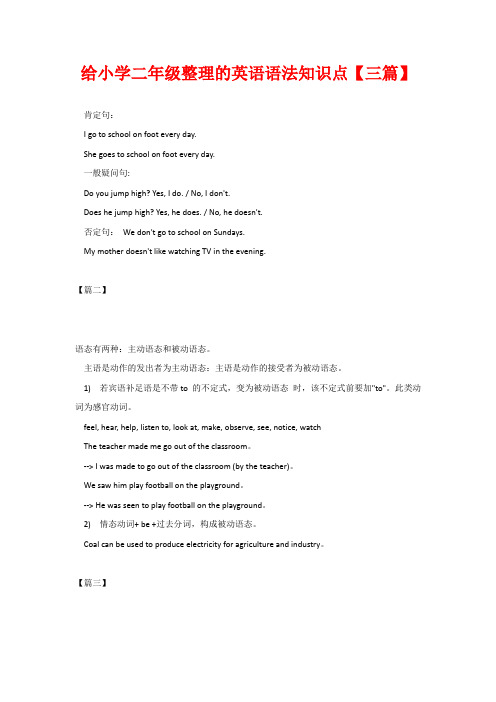
给小学二年级整理的英语语法知识点【三篇】肯定句:I go to school on foot every day.She goes to school on foot every day.一般疑问句:Do you jump high? Yes, I do. / No, I don't.Does he jump high? Yes, he does. / No, he doesn't.否定句:We don't go to school on Sundays.My mother doesn't like watching TV in the evening.【篇二】语态有两种:主动语态和被动语态。
主语是动作的发出者为主动语态:主语是动作的接受者为被动语态。
1)若宾语补足语是不带to 的不定式,变为被动语态时,该不定式前要加"to"。
此类动词为感官动词。
feel, hear, help, listen to, look at, make, observe, see, notice, watchThe teacher made me go out of the classroom。
--> I was made to go out of the classroom (by the teacher)。
We saw him play football on the playground。
--> He was seen to play football on the playground。
2)情态动词+ be +过去分词,构成被动语态。
Coal can be used to produce electricity for agriculture and industry。
【篇三】我们知道名词可以分为可数名词和不可数名词,而不可数名词它没有复数形式,但可数名词却有单数和复数之分,复数的构成如下:一)在后面加s。
二年级英语的语法知识点归纳
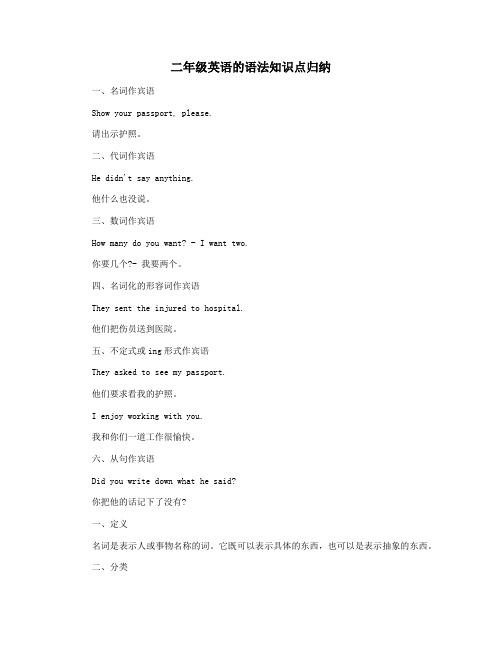
二年级英语的语法知识点归纳一、名词作宾语Show your passport, please.请出示护照。
二、代词作宾语He didn't say anything.他什么也没说。
三、数词作宾语How many do you want? - I want two.你要几个?- 我要两个。
四、名词化的形容词作宾语They sent the injured to hospital.他们把伤员送到医院。
五、不定式或ing形式作宾语They asked to see my passport.他们要求看我的护照。
I enjoy working with you.我和你们一道工作很愉快。
六、从句作宾语Did you write down what he said?你把他的话记下了没有?一、定义名词是表示人或事物名称的词。
它既可以表示具体的东西,也可以是表示抽象的东西。
二、分类1. 名词可以根据意义分为普通名词和专有名词如:John is a studentstudent是普通名词,John是专有名词普通名词前可以用不定冠词a/an, 定冠词the 或不加冠词,专有名词前一般不加冠词,专有名词的首字母要大写。
2. 普通名词又可以分为个体名词、集体名词、物质名词和抽象名词,其中个体名词与集体名词是可数名词,物质名词和抽象名称是不可数名词。
3. 专有名词专有名词是表示人名、地名、团体、机构、组织等的专有名词,多为独一无二的事物。
三、名词的数1、名词分为可数名词和不可数名词。
可数名词——可以数的名词不可数名词——数不清没有复数Drink?milk tea water orange juice coke coffee porridgeFood?rice bread meat fish fruit cake dumplings2、可数名词与不定冠词aan连用有数数形式,不可数名词不能与不定冠词aan连用,没有复数形式many+可数名词复数much/a little+不可数名词some, any , a lot of lots of 两者都可以修饰。
- 1、下载文档前请自行甄别文档内容的完整性,平台不提供额外的编辑、内容补充、找答案等附加服务。
- 2、"仅部分预览"的文档,不可在线预览部分如存在完整性等问题,可反馈申请退款(可完整预览的文档不适用该条件!)。
- 3、如文档侵犯您的权益,请联系客服反馈,我们会尽快为您处理(人工客服工作时间:9:00-18:30)。
小学二年级英语语法总结
动词的过去式词尾变化有几种:
1.一般情况下加ed,如watched, planted, watered, pulled, climbed, picked。
2.以不发音字母e结尾的加d,如liked, mo*ed, tasted。
3.以辅音字母加y结尾的变y为i再加ed,如study——studied。
4.以1个元音字母加1个辅音字母结尾的重读闭音节,双写最后一个辅音字母再加ed,如stop——stopped。
词尾读音有3种:
a.在浊辅音和元音后读[d],如li*ed, watered, listened, played。
b.在清辅音后读[t],如liked, helped, watched。
c.在[t],[d]音后读[Id],如planted, wanted, handed(上交)。
不规则动词的过去式变化则没有什么规律,请大家背熟记牢:
sit —— sat throw —— threw am, is —— was
drink —— drank draw —— drew are —— were
sing —— sang fly ——flew do —— did
begin —— began grow —— grew ha*e, has —— had
swim —— swam put —— put may —— might
gi*e —— ga*e cut —— cut can —— could
ring —— rang let —— let shall ——should
run —— ran read —— read will —— would
ride —— rode catch —— caught go —— went
write —— wrote teach —— taught eat —— ate
dri*e —— dro*e think —— thought hear —— heard
keep —— kept buy —— bought see —— saw
sleep —— slept fight —— fought find —— found
sweep —— swept hold —— held wear —— wore
feel —— felt tell —— told meet —— met
come —— came get —— got mean —— meant
become —— became make —— made speak —— spoke
take —— took say —— said
1)is, am -was are-were
2) begin-began ring-rang drink-drank swim-swam gi*e-ga*e
sing-sang sit-sat run-ran ha*e-had make-made
come-came eat-ate
3) write-wrote ride-rode speak-spoke dri*e-dro*e stand-stood
tell-told win-won get-got take-took
4) sleep-slept sweep-swept feel-felt keep-kept
spell-spelt spend-spent bend-bent
meet-met go-went
5) know-knew fly-flew blow-blew grow-grew
throw-threw draw-drew (glow-glowed)
6) teach-taught catch-caught buy-bought
fight-fought think-thought
7) find-found hear-heard say-said lie-lay
see-saw learn-learnt mean-meant
8) put-put read-read cut-cut let-let
网络搜集整理,仅供参考。
